The Chevy Camaro has always been a more practical Corvette.
Similar performance when ordered with its available V8 – which is the same basic V8 you get in the Corvette, detuned slightly (on paper, at least) for appearances-sake – but for a lot less money and with at least two things you can’t get in a Corvette:
There may not be much legroom in those back seats anymore, but they’re still there. They make it at least possible to take more than one passenger along for the ride without strapping him to the roof..
You can also get something surprising in the Camaro: Not-bad gas mileage.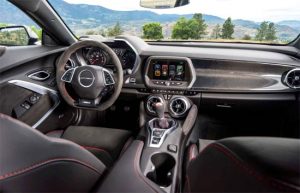
Although it is a rear-drive muscle car, it’s available with a fuel-efficient turbocharged four cylinder engine that can get 30 MPG on the highway. That’s only about 5 MPG less than most current front-wheel-drive economy cars get on the highway.
And front-wheel-drive economy cars do not get to 60 in 5.4 seconds.
The turbo-four Camaro can.
And with its optional V6 and V8 engines, it can get there even sooner.
The Camaro and its two rivals – the Ford Mustang and Dodge Challenger – are living legends connecting the present to the past, a time when Americans couldn’t get enough horsepower – and were still able to afford it.
There are plenty of high-powered rear-drive performance cars available today – but not many of them are available for the $25,000 Chevy asks for the base-trim LS Camaro, which comes with that potent turbocharged four cylinder engine mentioned above, a six-speed manual transmission and better performance (along with much better gas mileage) than almost all of the V8 muscle cars of the late ‘60s and early ‘70s delivered.
And if 5.4 seconds to 60 isn’t enough performance, you can upgrade to a 335 horsepower 3.6 liter V6 in the LT trim ($26,995) or a 455 horsepower V8 in the SS trim ($37,000) which will get you to 60 in 4.1 seconds.
To get there any quicker, you’ll have to give up the extra seats – and get a Corvette!
Lots of big changes for 2019, including a $1,000 price cut for the base LS trim and a new 1LE Performance Package for four cylinder-powered Camaros that bundles heavy-duty cooling, larger diameter front and rear stabilizer bars, firmer suspension tuning, upgraded 4-piston Brembo disc brakes, a 20-inch wheel/tire package and a limited slip rear differential.
All 2019 Camaro trims get updated front and rear styling, too.
There is also a credible rumor that Chevy will bring back the Z28 – possibly packing a 700 hp version of the Corvette’s V8 – sometime during 2019.
WHAT’S GOOD
Muscle car performance and looks – economy car starting price and gas mileage.
It’s got back seats.
Exceptional legroom up front (43.9 inches).
Those back seats have not much legroom (about 24 inches) and much less legroom than the backseats in the Mustang and Challenger.
Corvette has almost twice the trunk room (15 cubic feet vs. 9 in the Camaro).
Low-cut roofline and raked rear glass can make it hard to see what’s outside from the inside.
UNDER THE HOOD
Unlike its two muscle car rivals – which only offer two engines – Camaro is available with three.
The standard 2.0 liter turbocharged four makes 275 hp and 295 ft.-lbs. of torque at 3,000 RPM. This engine is both an economy engine – 20 city, 30 highway – and a performance engine (zero to 60 in 5.4 seconds).
The Ford Mustang offers a similar engine as standard equipment: a turbocharged 2.3 liter four that makes 310 hp and which is slightly more economical (21 city, 31 highway) and delivers slightly better performance (zero to 60 in 5.1 seconds).
The Dodge Challenger is the only one of the Big Three that still comes standard with a V6 (3.6 liters, 305 hp) but it’s much slower (zero to 60 in about 6.1 seconds) because it is much heavier (by about 600 pounds) and it is automatic-only when ordered with this engine.
Both Camaro and Mustang come standard with six-speed manual transmissions with their turbo’d four cylinder engines.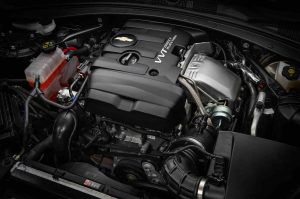
The Dodge is, however, uniquely available with all-wheel-drive (V6 versions only, for now). But an automatic-only/AWD (and so no burnouts) muscle car is kind of like a cheeseburger without the cheese.
Camaro’s middle engine is a 3.6 liter V6 that makes 335 hp. This is an interesting number because it’s the same number advertised by the 1970 Camaro Z28’s 5.7 liter (350 cubic inch) LT-1 V8 engine. And here’s another number: Zero to 60 in 5 seconds flat – quicker than the 1970 Z28.
Two more numbers to consider: 16 city, 27 highway. The 1970 Z28 was a magnificent beast but it couldn’t touch 27 MPG on the highway unless it was being towed and had its engine off. No overdrive gearing in those days. It was a four-speed manual or a three-speed automatic.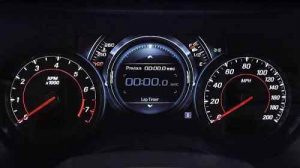
The 2018 Camaro has two more gears in its standard manual transmission and five more in its optional eight speed automatic (with the turbo four and the V6).
Neither the Mustang or the Challenger have middle engines; to get more power/performance than their standard engines offer, you have to buy the top-of-the line GT Mustang or the R/T Challenger, both of which come with V8s . . . and a much higher sticker price than the Camaro V6.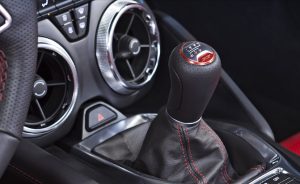
The base price of the Mustang GT is $35,355; the Challenger R/T starts at $34,100. This is $8,360 and $7,105 (respectively) more than the price of a V6 Camaro LT ($26,995). Of course, the V8 Mustang GT (5.0 V8, 460 hp) and Challenger R/T (5.7 V8, 375 hp) are more powerful and quicker than the V6-powered Camaro – but their high MSRP puts them out of the reach of many people – and that’s not counting their cost to insure.
It’s nice that Chevy offers a more reasonably priced but still high-performing version of the Camaro. You can also put the $7-8K you saved toward the Track Package that’s available with both the turbo four and the V6 Camaro. It outfits the car with almost all the enhancements you’d get in the V8 SS Camaro, but for under $30,000.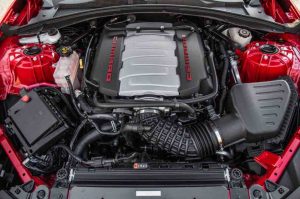
Speaking of the SS.
It comes standard with a 455 hp 6.2 liter V8 and your pick of either the the six-speed manual or (uniquely) a ten-speed automatic. Either way, this version of Camaro can bullet to 60 MPH in 3.9 seconds. A pleasant surprise is that despite almost twice the displacement vs. the V6, a 100 hp upgrade and a massive performance upgrade, the thing is still capable of 16 city, 24 highway – only slightly thirstier than the V6.
Assuming, of course, you can resist making full use of those 455 horses.
Whether you buy the four, the six or the V8, you’ll get where you’re going in a hurry.
Your dilemma will be whether to get where you’re headed even more quickly by going with the V6 or at light-speed with the top-of-the-line V8.
The turbo four is arguably the most interesting Camaro powerplant.
It’s affordable and its mileage is exceptional, but without any real sacrifice in performance vs. the more expensive V6. The difference in 0-60 capability is so tight that a turbo Camaro driver with faster reflexes – who drops the hammer first and bangs off quicker shifts – will be able to outrun a lesser driver behind the wheel of the V6 Camaro.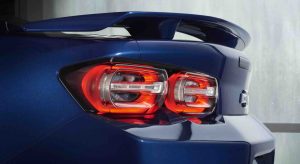
The turbo four also feels stronger at part-throttle in the low and mid ranges . . . because it is. There’s more torque (295 ft.-lbs. vs. 284 ft.-lbs. for the V6) and the four’s torque peak arrives at 3,000 RPM vs. 5,300 RPM for the V6. There’s less need to spin the four – and it works really well with the optional automatic – something one usually has to be concerned about with four cylinder engines in heavy cars.
But not in this car.
The V6 has its merits, too – especially since the Mustang doesn’t offer one anymore and the Challenger V6 doesn’t offer a manual transmission to go with it. The latter is kind of like the low-performance versions of the GTO Pontiac offered in the ’60s; all hat and no cattle, as they say in Texas.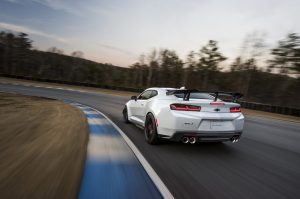
The 6.2 V8 in the SS V8 reverses the dynamic vs. the Mustang GT’s 5.0 V8.
It’s a big-cube brawler that makes slightly less horsepower than the GT’s V8 (455 vs. 460) but makes its peak lower down in the power band – at 6,000 RPM vs. a peaky 7,000 RPM for the smaller 5.0 V8 in the Ford.
Which also makes significantly less torque – 420 ft.-lbs. vs. 455 from the Corvette-shared 6.2 V8.
The result is a kind of Mexican standoff, acceleration-wise.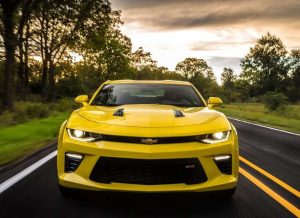
The Ford is capable of edging out the Chevy – but only just barely and assuming both drivers are equally competent. The real difference is in terms of feel. Camaro is arguably more faithful to the brutal performance ethic that defined the original muscle cars of the ’60s and ’70s. The Mustang’s high-revving overhead cam engine is a more refined engine – not that there’s anything wrong with that.
But it’s not as . . brutal.
The SS can light the tires up all the way through third gear – without calling up everything it’s got. Burnouts are not as accessible in the Mustang. It’s a finesse machine, as far as muscle cars go.
This includes its much better ergonomics and visibility.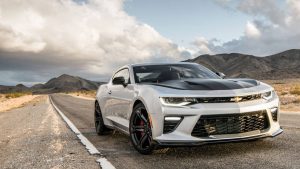
Camaro sometimes feels like it occupies every inch of pavement in between the double yellow to your left and the white shoulder line to your right. And the visibility is not just bad.
It’s brutal.
The car is much tougher to live with as an everyday driver than the Mustang – or the Challenger, which is a much larger and more easygoing car than either the Camaro or the Mustang.
The current Camaro is the closest yet to being a hunkier four-seater Corvette. The back seats are almost nonexistent – even for a muscle car. GM does not even publish a legroom number, but it is around 24 inches.
How brutal is that?
The Mustang has 29 inches; the Challenger 33.1 inches. That’s a five inch difference in legroom for the Ford vs. the Chevy – and almost a foot’s difference vs. the Dodge.
The car’s trunk is also very small for such a relatively big car. Just 9.1 cubic feet (7.3 cubic feet for the convertible). That is beyond brutal.
My motorcycle has more cargo capacity – no joke.
The Mustang’s got a 13.5 cubic foot trunk – close to the space you’d get in some current mid-sized sedans (a 2018 Toyota Camry has a 15.1 cubic foot trunk). The Charger’s trunk – 16.2 cubic feet – is larger than the trunks of most current mid-sized sedans.
Camaro needs those back seats – to make up for the lack of trunk. You can at least put whatever you need to carry there. But – whoops! – now you can’t carry passengers back there.
While there is plenty of legroom up front (43.9 inches) headroom is marginal for drivers more than six feet tall and even shorter drivers may find the Camaro’s cabin claustrophobic. You sit really low in the thing and feel surrounded by by the high doors and the heavy-looking dashboard.
These ergonomic defects – which also result in terrible outward visibility – really put the arm on the Camaro’s practical Corvette appeal.
Chevy ought to decide to either go whole hog and make the Camaro a two-seater or give it a less ridiculous back seat – and a viable trunk. More headroom needs to be carved out somehow – and the visibility problem needs to be dealt with.
There is a reason why the Camaro’s not selling nearly as well as the Mustang or the Challenger (more about that here). This is a car that has limited appeal beyond young singles – mostly young single males – who don’t have to care about usable back seats and a viable trunk.
Until they aren’t single anymore.
Then it’s Mustang – or Challenger – time.
THE REST
All Camaros get updated touchscreen (seven inch standard, eight-inch optional) with cloud connectivity, 4G wi-fi and an updated app suite.
As mentioned above, you can upgrade both the turbo four and the V6 Camaros with a very comprehensive track package, which includes pretty much everything you’d get if you bought the V8 SS (including 20-inch wheels with “summer” ultra-performance) tires, launch control, and driver-selectable Competition/Track modes with shift lights and a plethora of performance readouts/data such as lap and 0-60 times, lateral G forces and other such things.
Ford and Dodge offer similar things – but most of them are only offered with the V8 versions of those cars, which means spending close to $40k to get those things.
Camaro’s a bargain in another way.
Because sales are down – due to the ergonomic issues, probably – Chevy has cut the car’s asking price significantly. But it’s more than just $1,000 off the MSRP vs. last year. Slow sales equals a better haggling position.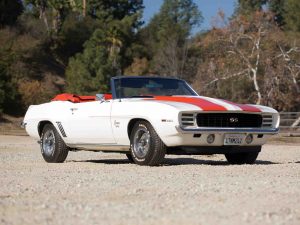
It’s a good bet you could buy a new Camaro turbo or V6 Camaro – with the track equipment – for around $26-27k or so, maybe less.
Which would buying a new Camaro even bitchin’ – even if the back seats are ridiculous and the trunk next to useless.
THE BOTTOM LINE
Camaro has its flaws – but value, performance and economy aren’t among them.
. . .
Got a question about cars – or anything else? Click on the “ask Eric” link and send ’em in!
If you like what you’ve found here – and don’t like Goo-guhl or FacePlantBook – please consider supporting EPautos.
We depend on you to keep the wheels turning!
Our donate button is here.
If you prefer not to use PayPal, our mailing address is:
EPautos
721 Hummingbird Lane SE
Copper Hill, VA 24079
PS: EPautos magnets are free to those who send in $20 or more. My latest eBook is also available for your favorite price – free! Click here. If you find it useful, consider contributing a couple of bucks! 


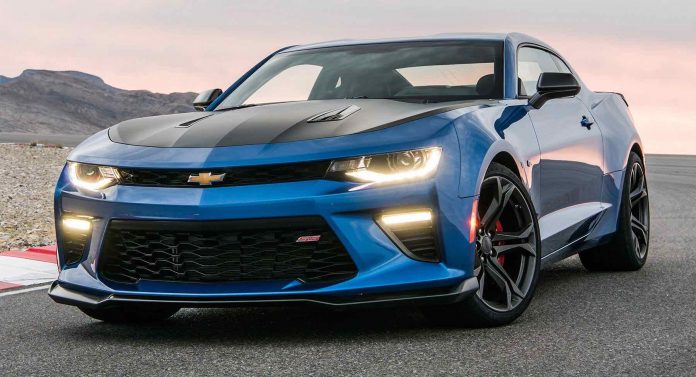



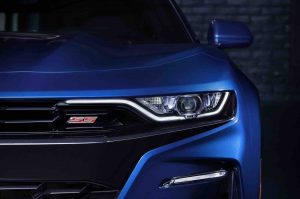
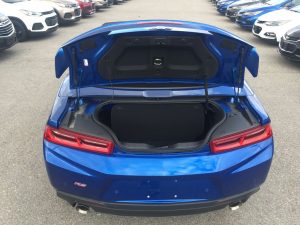
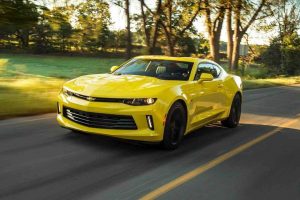
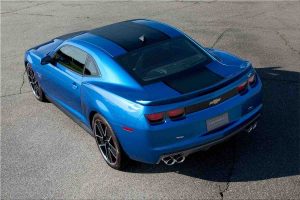
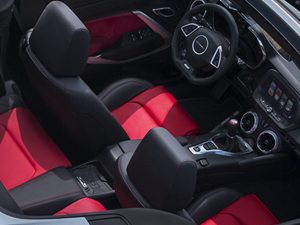








If I couldn’t get a ’69, I’ve always wanted a ’92 z28. Hated the design of the 4th gen.
Hi Freak,
I stopped being into Camaros after the Third Gen, too. The Fourth Gen cars (and the current car) were much stronger, quicker… but I’d still rather have an ’84 L69 HO!
I can’t stand the Camaro for the ergonomic problems you stated. I sat in one one time, and felt very claustrophobic in it. You can barely see anything out of the windows. Mustang and Challenger have a lot more going for them in the ergonomics department by a wide margin.
I just bought a vintage 1987 Buick GNX. One of the things I love about the car is its excellent visibility out along with the solid power of course. Being able to see out the car is really nice! Hondas used to be famous for that. Low hoodlines and expansive glass all the way around. I had an Integra GSR for years I loved for that reason. Just a great seating position and you can see everything. Preludes and Civics were good then too. Oh well now every car is the same boring blob pretty much.
Personally, I think the new (2010-today) Camaro is hideous. I suspect someone at GM said ‘Hey, the retro Mustang worked, let’s try that”. Then handed the project off to a bunch of kids fresh out of the Diploma Mill, born 20-30 years after the car they were to retro/copy/design came out, with no clue as to the culture around the car, who trotted off to their CAD workstations. Then drove home in their Prius.
Thus this POS.
And, why settle for a copy?
https://www.hemmings.com/classifieds/?makeFacet=Chevrolet&modelFacet%5B%5D=Camaro&adtypeFacet=Vehicles%20for%20Sale&year_min=1967&year_max=1973&sort=price_asc&start=15
Even a ‘project’ car reworked makes more financial sense in the long run. Cheaper insurance, DIY maintenance, better long term investment value (IMO) and WAY cooler than a re-skinned and slightly modified Austrailian Ute. Hell, if they just brought the Utes over, that would be better.
Hi Cold,
I can’t argue with you on this; and I say that as a guy who has owned five F cars … but all second and third gen cars. I love my ’76 TA and wish I still had my ’80 Z28. The ’80 was a four speed car with T-tops and a mostly stock 350. It wasn’t very fast by today’s standards, but it was just a fun car to drive.
My ’76 is fast. And the sound of the Quadrajet opening up is among my favorite things in life! The car has the “federal” 5 MPH front end, but Pontiac did a damned fine job making it look good. The tail is gorgeous – better looking (my opinion) than the tail end of the ’70-73 models, which are generally considered the purest of the breed.
GM never equaled the design beauty of the ’70-81 TA’s dashboard.
eric said, “It wasn’t very fast by today’s standards, but it was just a fun car to drive.”
That is the crux for me. Fast? Really, who cares?
It is better to rive a slow car fast, than a fast car slow.
I have been in some extremely fast vehicles over the years and two major things stand out. One, they are boring as hell at the speed limit. Two, having fun in them means the risk of jail time or a likely fatal crash.
The old man had dozens of vehicles at any given time, because he was a car dealer and restorer. I drove lots of them. Most fun I ever had was in a 1980 Chevette 4speed. Least fun, a Lotus Esprit.
The Chevette was a blast because it had to be driven hard just to get to the speed limit. The skinny tires made cornering at 50mph hilariously fun.
The Lotus was extremely quick and fast. But you could only use 20% of the performance most of the time. Getting the tail out did not happen at anything less than double the speed limit. It was boring most of the time, scary when used to it’s potential.
With old classics you get comparatively poor reliability, safety, and fuel economy. Looks are always subjective but I think the 2019 looks way better than any other Camaro made after the 60s. I grew up in the 80s and 90s and my dad had a Corvette ZR1, Formula Firebird, Bonneville SSEi, etc. They were great cars, especially compared to what was available in the 70s and early 80s. If the packaging weren’t so bad on this new Camaro, I’d say GM would have a winner all around. Unfortunately I need AWD where I live and the modded up Scion tC that I use as a beater car isn’t ready to move on just yet. I have a pair of newish Volvos for winter and had been eyeing a Fiat 124 Abarth as an eventual play car (to replace the tC). The Camaro is looking more and more like it should be on my list. Especially if I can get one dirt cheap…
Hi AMS,
I won’t argue saaaaaaaaafety – the old cars lacked all the stuff that encrusts new cars – but I consider that to be one of the attractions of the old stuff! As far as reliability: It’s nuanced. Yes, the older stuff needed more in the way of minor maintenance – and it’s true that they didn’t last as long. But, they were easier and much less expensive to maintain and repair. As an example, I can go through the entire “fuel system” in my Trans-Am for less than $100. That’s how much a new fuel pump and a rebuild kit for the Quadrajet cost. Once rebuilt, the carb is good as new again. A new Camaro has DI and numerous peripherals; yes, they all work perfectly (usually) for a long time. But, when the car reaches 12-15 years or so, those complex systems are approaching the end of their useful service life and most electronic parts are not rebuildable. They must be replaced. The fuel system in a car like the new Camaro entails more expense – eventually – than rebuilding the entire drivetrain in my TA.
I will say that the fuel economy, power and performance of the new Camaro are superb. It’s a shame about the atrocious ergos of the car, though.
If the electronic parts are even available for sale then no matter what the price. If you can’t get a rebuild kit for your carb you might be able to work something out or even swap carbs with a little work, but how are you going to swap out or “make do” on an electronic part?
I believe all modern cars are just throwaways in the end because of electronics. Fifty years from now you will not be able to find an ECM, BCM or whatever else electronic gizmo for your “classic” 2018 Chevrolet.
There are aftermarket electronic engine control systems on the market now.
“With old classics you get comparatively poor reliability, safety, and fuel economy.”
Stock, yes.
But, a simple TBI and electronic igniton on a 1970 engine solves 90% of the problems. $2000 tops. In an old lightweight, a late 80’s or newer transmission with OD will likely get better mileage than a lot of the new stuff, simply due to being 1000lbs lighter.
And on reliability, several friends have had newer (2010+) vehicles brand new. Almost all have been in the shop for warranty work within the first year. Often again for the same problem a year or two later. New stuff is just too complex. The vehicles I owned in the 80’s and 90’s never seemed to have any problems, other than occasionally requiring a tune up.
Oh, and that high pressure direct injection fuel pump(s) on all new stuff? Pricey. VERY pricey.
Safety? Well, sure, they are not as ‘safe’ if you crash. But how safe is required? I have been in two rollovers, one a 1980’s Toyota, one a 1980 Ford truck. Both wrote the vehicles off, but the passenger compartment was fine and everyone walked away.
The new Camaro and many new ‘bathtub’ designs, have sight lines that make a crash more likely. These things have the outward visibility of a submarine.
Regarding the Camaro and other cars, I believe that is precisely the reason that highway accidents and fatalities have increased in the last 5 years or so even after adjusting for increased miles driven and other factors. The dizzying amount of touch screen and telematics coupled with poor transmission shift quality and delayed throttle response has contributed to reduced safety margins. Add that the essentially gunslit windows on the new cars, and i’m not surprised that insurance companies are raising their rates. I will turn purple before this ever gets addressed.
What isn’t discussed much is reliability/quality. I’ve owned three F-Bodies, two 2nd gen Camaros and a 1988 Trans Am GTA. All had major defects which made them as much “hobbies” as transportation.
My last “sports car” purchase was a 2012 Infiniti G37 which has had zero defects. I’m no longer in the market for new vehicles as hobbies.
Hi Liberty,
I’ve owned three second gen cars – and, sure – their build quality was very poor compared with anything modern. But it’s not really fair to compare a car designed in the late ’60s and made in the ’70s (ok, through 1981) with a 2012 model anything!
Same goes for the ’88 GTA!
Customer reliability surveys taken by Consumer Reports rate the current Camaro at Consumer Reports worst rating. Not worth the risk – I’ll continue to pass.
in the past, GM sicced their lawyers on me, rather than fixing their mistakes. I’m a recovering, once all-GM guy.
Hi Libertyx,
Take CR with a grain of salt. They are massively biased against American cars and loathe American muscle cars. Observe the gentle treatment they’ve given Tesla…
Exactly! If you’ve ever driven the cars they praise, you’ll quickly find that they prefer mom-mobiles. The whole CR automotive team should probably be let go and replaced with folks who are far less cloverish…
“If you’ve ever driven the cars they praise…”
I’ve done more – I own one.
The vehicle I tested/purchased, after reading a super positive CR review, with a 95 rating – 2012 Infinite G37. CR remarks: Highs – “acceleration, handling, transmission, braking, front–seat comfort, fit and finish”. No disagreement, along with above average reliability.
Hp – 330, quarter-mile in the 13s, 0-60 5.3sec.
Reference: April 2012 Consumer Reports
Gosh, I don’t see any significant changes between this 2019 model vs the one that has tanked in the market…and that you panned in your post just 9 days ago.
A $1000.00 price reduction?? More “interesting” tuning on the 4 banger turbo? The fact that it has a “middle” (not “mid”) V-6 engine? The inference that the “maybe” Z-28 is “maybe” closer to market than before?
Still seems to quack and gobble like the same old Turducken. Did I miss something? 😉
Hi Mike,
Nope – you missed nothing!
I do like that the car offers very solid (and RWD) performance for about $25k, sticker. That is undoubtedly cool. But the ergonomic problems are severe and really compromise the car. Not that muscle cars are supposed to be practical. But this one takes it to a new extreme.
I say this as an F-car guy, too – as most of the regulars here already know. I root for the car because I’d hate to see it go away. But it needs fixing – soon and badly.
Guess they’ll all do OK in Classic Car Auctions 40 years from now. Glaring ergonomic faults won’t matter much when nobody’s really going to street drive them anyway.
Hard to speculate which brands and models will get the crazy-highest bids. Of only one thing am I sure…….. It won’t be the turbo fours…or the V-6s.
GM got a lot of sales on pent up demand from the car being gone for so long. That’s used up so now the merits mean much more. Now it seems they are making similar mistakes as they did last time. Pushing styling to places where few people want it, destroying any practicality, and then trying to smooth it all over with more power.
Hi Brent,
Yup.
The second and third gen cars were much better designed – and sold in big numbers. The third gen cars especially were very well thought out; the large hatchback endowed them with a lot of cargo room for the type of car they were and the expansive glass gave great visibility. They were very light, too (vs. the second gen. cars) and that helped with economy and performance.
Things went wrong with the Batmobile design 4th gen cars ad haven’t been right since…